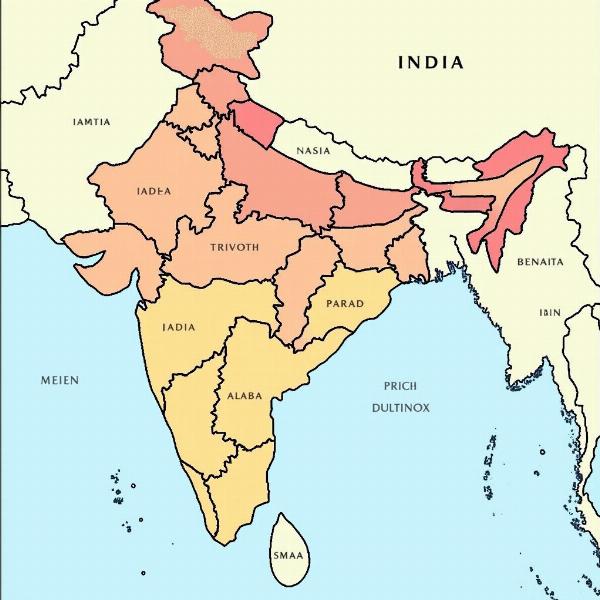Understanding the meaning of “princely state” in Hindi is crucial for anyone interested in Indian history, politics, and culture. This term, often translated as “riyasat” (रियासत), refers to a territory ruled by a native Indian ruler under the paramountcy of the British Crown during the British Raj. These states enjoyed a degree of internal autonomy but were ultimately subordinate to British authority. Let’s delve deeper into the historical context, significance, and various aspects of princely states in India.
The Historical Context of Princely States
 Map of Princely States in India
Map of Princely States in India
The system of princely states emerged from the complex political landscape of India under British rule. As the British East India Company expanded its influence, it adopted a policy of subsidiary alliances and treaties with existing Indian rulers. This allowed them to maintain control without directly administering the entire subcontinent. These agreements transformed formerly independent kingdoms into princely states, acknowledging their sovereignty while simultaneously limiting their power.
Riyasat (रियासत): The Hindi Term for Princely State
The Hindi word “riyasat” (रियासत) encapsulates the essence of a princely state. It signifies not just a territory but also the authority and prestige associated with its ruler. The term carries connotations of royalty, tradition, and a distinct political identity. While under British paramountcy, these “riyasats” retained their cultural and social structures, contributing to the rich tapestry of Indian heritage.
What did it mean to be a ruler of a princely state?
Being a ruler, or “Raja” (राजा) or “Maharaja” (महाराजा) of a princely state meant navigating a delicate balance between internal autonomy and external subordination. They held considerable power within their territories, managing their own administrations, judicial systems, and even military forces. However, their foreign policy and major decisions were subject to British oversight.
Categories and Administration of Princely States
Princely states were categorized based on factors like size, population, and revenue. Salute states, for example, were ranked based on the number of gun salutes accorded to their rulers, reflecting their relative importance. The British Crown represented by a Resident or Agent advised the rulers on administrative matters, ensuring compliance with British interests.
How did the British influence the administration of princely states?
The British influence on princely state administration was significant, though indirect. Through Residents and Agents, they exerted control over key decisions and policies. While rulers retained internal autonomy, the British often intervened in matters of succession, finance, and internal disputes, ensuring that their interests were safeguarded.
The Integration of Princely States into India
Following India’s independence in 1947, Sardar Vallabhbhai Patel played a pivotal role in integrating the princely states into the newly formed nation. This process involved complex negotiations, political maneuvering, and the use of both persuasion and pressure. The integration of these states was a monumental achievement, consolidating India’s territorial integrity and forging a unified nation.
Conclusion
The term “princely state,” or “riyasat” (रियासत) in Hindi, represents a significant chapter in Indian history. Understanding its meaning and implications is essential for comprehending the complexities of India’s past and its present political landscape. These states, while under British paramountcy, played a crucial role in shaping India’s diverse cultural and political fabric. Their integration into independent India marks a turning point in the nation’s history, solidifying its unity and sovereignty.
FAQ
- What is the difference between a princely state and a British province? Princely states were ruled by Indian rulers under British suzerainty, while British provinces were directly administered by the British Crown.
- How many princely states existed in India? There were over 560 princely states in India at the time of independence.
- What was the role of the British Resident in a princely state? The British Resident acted as an advisor to the ruler and represented the interests of the British Crown.
- Why were princely states integrated into India after independence? The integration of princely states was crucial for creating a unified and politically stable India.
- What were the challenges faced during the integration process? The integration process faced challenges such as resistance from some rulers, complex legal issues, and logistical difficulties.
- What is the legacy of princely states in modern India? The legacy of princely states can be seen in India’s diverse cultural heritage, historical monuments, and even its administrative structure.
- Where can I find more information about specific princely states? Numerous historical archives, books, and online resources provide detailed information about individual princely states.
Related Articles
your highness meaning in hindi
her highness meaning in hindi
Meaning-Hindi.in is your premier destination for high-quality Hindi translation services. We specialize in business, legal, technical, website localization, educational, and specialized translations. Our team of expert linguists and subject matter experts ensures accurate and culturally sensitive translations tailored to your specific needs. Whether you need a document translated quickly or require specialized expertise, Meaning-Hindi.in is here to help. Contact us at [email protected] or call us at +91 11-4502-7584 to discuss your translation requirements.